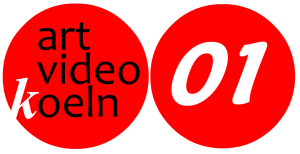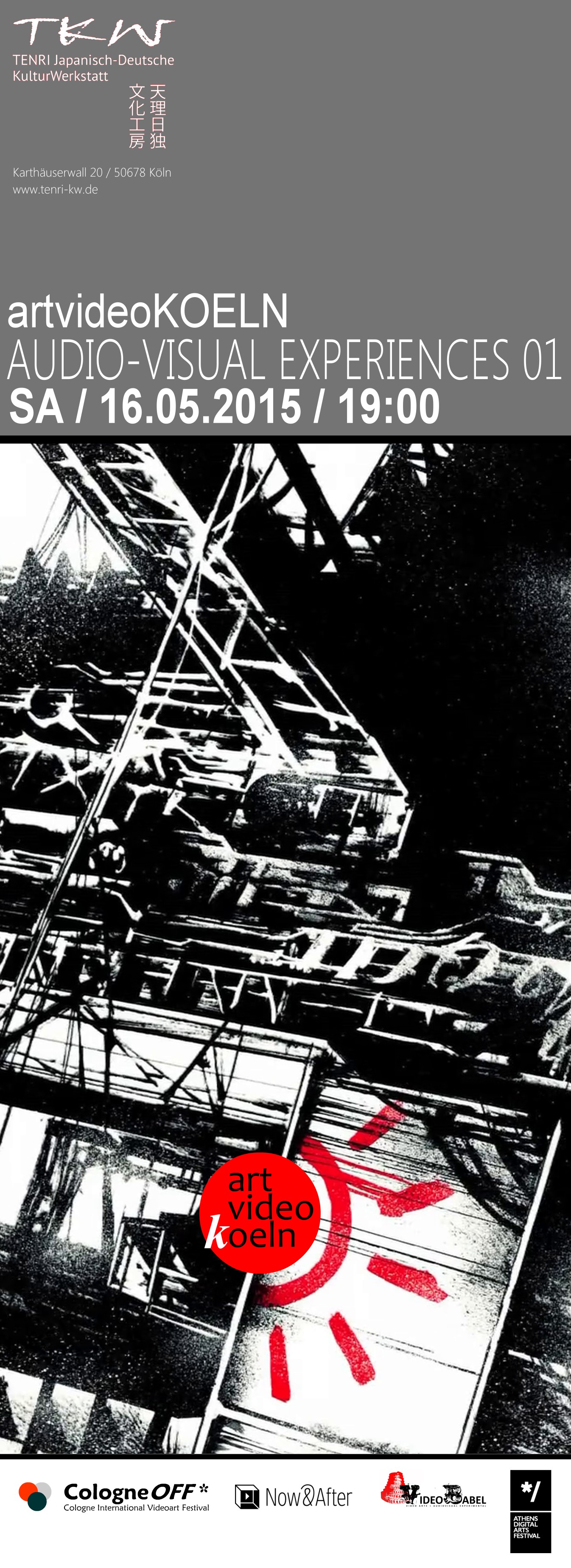
artvideoKOELN – audiovisual experiences 01
Program III
No Home
Anca Bucur (Romania) – The confession of an aphasic writer, 2014, 3’31â€
Wrik Mead (Canada) – summer 1975, 2014, 9 min 56 sec +
Gregg Biermann (USA) – Iterations, 2014, 5:37 +
Tiziano Bellomi (Italy) – Double identity, 2014, 00:58 +
Dimitris Argyriou (Greece) – First Contact, 2013, 06:56 +
Danijel Zezelj (Croatia) – Thousand, 2014, 05 min : 37 sec +
Neil Ira Needleman (USA) – AmericaAntiAmerica, 2014, 03:45
Dee Hood (USA) – It’s A Process, 2014, 2:35
Maureen Bachaus (NL) – Do dreams merge with reality?, 2015, 03:22
Tushar Waghela (India) – The Home, 2014, 5:45
Kushtrim zeqiri (Kosovo) – Stay Strong, 2014, 00:01:30, 2014
Machia & Lolina (UK) – Chamelion Seeking Colour, 2015, 7’ 40″ +
Bruno Pavic (Croatia) – 35 faces of homeless, 2012, 3’42â€
Riccardo Matlakas (italy) – Transitory State, 2015, 6:02
Lisa Birke (Canada) – Tea Service, 2013, 5 min
Marina Chernikova (Russia) – About About It, 2013, 4 min
Damian Gromala (Poland) – PsychoKinetic, 2014, 5:11
Ayman Alazraq (Palestinian) – Oslo Syndrome, 2014, 6:30
Livia Ungur and Sherng-Lee Huang (USA) – “Prodigalâ€: 2015, 8 min 17 secs
Michael Salkeld (UK) – Audio Visual Poison, 2014, 3:20
Details
Anca Bucur (Romania)
The confession of an aphasic writer, 2014, 3’31â€
The confession of an aphasic writer is a videopoem based on the main statements of Wittgenstein’s Tractatus Logico-Philosophicus which put into discussion the relation between language and reality, focusing upon the structural isomorphism, the logical identity between the two. The aphasic subject finds himself in the impossibility of actualizing the connection between reality and language, lacking the capacity of expressing the language he contains and which in turn contains him. Therefore, his only solution remains the invention of a new language which would legitimate his existence in a linguistically structured world.The videopoem is generated by a program coded to synchronize the frequency levels of the voice with the visuals. Glitches are produced by randomly altering bytes in each frame and the amount of randomness is determined by the sound spectrum. The interrupted, fuzzy, glitched image constitutes a representation of the incomplete aphasic discourse, while the polyphony emphasizes the necessity of repetition into (dez)organizing the body
Wrik Mead (Canada)
Summer 1975, 2014, 9 min 56
summer 1975 is part of an installation that first exhibited at PayneShurvell Gallery in London, UK. Artlyst voted it “Our Pick of the latest Emerging Art†and Abigail Addison of Animate Projects Ltd put 1975 on her top ten animations of 2013 list.
It’s is an animated film based on one year in the filmmakers fractured life. Hand drawn rotoscoped figures are layered with stills and live video footage to create an open narrative based on events in his life that took place in 1975.
He was 13 and this was a pivotal year for him in many ways. He discovered the magic of animation and was hooked. He made his first animated film with his best friend, they locked themselves away for the whole summer to complete it. 1975 was also the year that he had his first sexual experience, with said best friend. It was a time of great excitement, confusion, fear and withdrawal.
Gregg Biermann (USA)
Iterations, 2014, 5:37
In Iterations, a scene from Hitchcock’s Rear Window (1954) is sliced into nineteen columns, each moving at a slightly different speed, growing progressively faster from left to right. Only at one instant do all nineteen columns briefly align. Rear Window is a film about the desire to see and thereby to understand—or misunderstand. Biermann’s film invites us to experience different instants of the scene simultaneously, invoking our desire for coherence but only briefly allowing for this satisfaction. Like Jimmy Stewart’s character in Rear Window, we are thwarted in our visual desire as our scopophilic satisfaction is deferred. –Jaimie Baron
Tiziano Bellomi (Italy)
Double identity, 2014, 00:58
Identity is contextual and relational, it can vary depending on the context, the role that you want to assume in this context and the position, covering multiple roles within the network of relationships in which there is inscribed.
Dimitris Argyriou (Greece)
First Contact, 2013, 06:56
“Have You Ever Fall In Love?” – First Contact is a metaphor about falling in love.
Danijel Zezelj (Croatia)
Thousand, 2014, 05:37
All is grey. The sun has not been rising for years. There is a legend going around the city: Paint the sun a 1000 times and it will rise again.
Neil Ira Needleman (USA)
AmericaAntiAmerica, 2014, 03:45
A short, light philosophical video that asks questions about the meaning and power of imagery, and the nature of patriotic (and anti-patriotic) acts. It asks the questions, but it’s up to you to answer them.
Dee Hood (USA) –
It’s A Process, 2014, 2:35
In life and art, it’s about the process…. Learning to trust our instincts, trying to nurture authenticity.
As Paul Klee said, “becoming is superior to beingâ€
Maureen Bachaus (NL)
Do dreams merge with reality?, 2015, 03:22
The stream of thoughts in the video is about essential issues of human existence, like quantifying love, the meaning and influence of our dreams, and the possible existence of a past life. The rope, sometimes in a knot, symbolizes the limitation or even captivity but also the freedom experienced by certain thoughts and feelings. a house is an unconscious symbol for your body and mind. The ritual, carried out by a young woman, is a symbol of her thoughts and feelings.
Tushar Waghela (India)
The Home, 2014, 5:45
The home where we live is also a home to billions of living beings. They might remain out of our vision, their sounds and signs continuously register their presence before us. We believe ourselves to be the owner of our apartments and push them away from our kitchen and courtyard. Barely do we realise that much before we came into existence this planet has been their domicile for billions of years —- our apartments are just a tiny corner of their vast habitat.
Kushtrim Zeqiri (Kosovo)
Stay Strong, 2014, 00:01:30, 2014
This video show a position of human being that is always attacked in indirect or direct form by people in temporary function positions, and i make this video with a message to stay strong and never give up from those storms!
Machia & Lolina (UK)
Chamelion Seeking Colour, 2015, 7’ 40″
In a darkened room, children whisper secrets to each other and enter a world of pigments. They imagine geometrical shapes that mutate like chromophores. The ability to change their colour is a notorious characteristic of the chameleons, but only recently it has been observed that they love dressing up as housewives, metalworkers, greengrocers.
Filmmaker Martina Moor and animator Giulia Palombino were commissioned by Fondazione Magica Cleme Onlus to create a playful short film with a group of children who are currently undergoing therapeutic cancer treatment. The children are both protagonists and co-authors of the film.
Bruno Pavic (Croatia)
35 faces of homeless, 2012, 3’42â€
Riccardo Matlakas (italy)
Transitory State, 2015, 6:02
Transitory state, talks about our state as human being, and our being humans in a “state” where things don’t really look at the true human needs but everything plays around power, excess and extremities. A world where capitalism is the ruler. This video shows a post-apocalyptic view of what out objects of desire will end one day. A text read out from a machine with still human wonderings and insights.
Lisa Birke (Canada)
Tea Service, 2013, 5:00
Set in a rustic romantic landscape, our heroine enters swinging a picnic basket. She proceeds to set out her finest china on her lace linen in order to serve tea. In a twist of the plot, the tea service takes a violent turn and is metaphorically interrupted through “the chopping of woodâ€. Revealing our gendered expectations we look straight into the eyes of the trope of the psychotic or hysterical female character repressed by stoic femininity. As if nothing out of the ordinary has occurred the tea service is concluded leaving the viewer to pick up the pieces.
Marina Chernikova (Russia)
About About It, 2013, 4:00
The image of Mayakovsky, his artistic practice that wanted to define new esthetics and the ideas of the artistic avant-garde of the Twenties have become sources of inspiration for
this experimental documentary. Digital editing unites contemporary images of the streets of Moscow, Berlin and Paris with fragments from the Twenties avant-garde films in the dynamical journey of Mayakovsky, to come to his tragic end in the static space of his room. The fragments from films by Dziga Vertov “Man with a Moving Camera”, Walter Ruttmann “Berlin. Die Sinfonie der Großstadt”, René Clair “Paris qui dort”, Hans Richter “Filmstudie” were used.
Damian Gromala (Poland)
PsychoKinetic, 2014, 5:11
The movement, emotion, abstraction – that is all what can be relayed without using words. A short experimental movie about movement theatre reveals magic of improvisation and the strength of impulse which can turn into (non)logical form.
Ayman Alazraq (Palestinian)
Oslo Syndrome, 2014, 6:30
Year 2013 brought the Oslo Agreement to the spotlight all over. It brought me back to 20 years ago, when I had a dream now lost. This dream haunts me again. I feel as if I’m sitting in a train station watching trains and people come and go. They all have a destination to reach as I wait for a train that might never arrive.
Livia Ungur and Sherng-Lee Huang (USA)
“Prodigalâ€: 2015, 8:17
This experimental documentary tracks the complicated relationship between filmmaker Livia Ungur and the place she used to call home. Visiting her native Romania after living in the U.S. for many years, Livia (along with husband and collaborator Sherng-Lee Huang) shot “Prodigal” on the streets of Bucharest. They secretly filmed strangers from a great distance with a telephoto lens. Afterwards, Livia attempted to eavesdrop on the strangers’ conversations by reading their lips. What emerges is Livia’s own story and a uniquely personal spin on the city symphony film.
Michael Salkeld (UK)
Audio Visual Poison, 2014, 3:20
Made in 2.39:1Cinemascope with surround sound to place the audiences at the centre of the orchestration composed my the director,The experimental abstract visuals interpret the complexity of the score.

